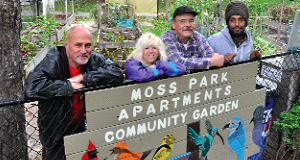Dennis Hanagan –
Residents at the Moss Park apartment buildings have made good use of green space outside their 285 Shuter St. building for the past three summers. They turned a large portion of the lawn on the Queen St. side into a vegetable garden.

Moss Park Community Garden Leaders l-r: Dennis Hawkins, Leona Lowe, Gerald Graf and Said Hassan.
On Oct. 15 they gathered in the common room for a harvest dinner. Pizza and chocolate cake made up part of the menu but so did garden produce—carrots, green peppers, green onions, garlic and cherry tomatoes.
Dennis Hawkins, who got the garden started in 2012, says gardeners are able to supplement their daily meals throughout the summer with stuff they’ve grown. The patch has also brought social benefits.
“The garden has been a big impact,” he says. “It’s brought the community together. They’re learning to get along together and they’re exchanging recipes.”
As for himself he’s able to take a pail of produce at least once a week to the People With AIDS food bank. Building community is high on his list of things to do. He won an award this year for his community work.
There’s a new garden leader every year. First it was Hawkins, then Leona Lowe, then Gerald Graf and next year it’ll be Said Hassan.
Graf says he reaped 15 pails of tomatoes this summer from his section of the garden alone. It’s divided into 44 beds. There’s a section for seniors and another for children.
Efren Codina’s 11-year-old son Gabriel loves getting his hands dirty planting tomatoes, squash, peppers and watermelon. The family moved into the Moss Park complex last summer.
“He’s learning how long it takes for things to grow and bear fruit,” says his dad. “He’s learning by first-hand experience.” Before he started in the garden he grew plants on his balcony. But there were limitations to that. “He was complaining he didn’t have enough space,” says Efren.
Before moving to Toronto the family lived in the Kitchener area. “They have lots of farms there. That’s where he (Gabriel) started to love plants and farms.”
What’s he want to be when he grows up? “He was saying he’d like to be a farmer,” says Efren.
William Easter takes care of the composting and teaches the children what to add to make it germinate. A lot of tenants help out by bringing him their kitchen scraps.
He gets help from a nearby coffee shop, too, where he collects coffee grounds and egg shells from the egg sandwiches they make. “I compost from them to add into our garden to make it a much more richer soil.”
The grounds are full of nutrients, says Easter. But you have to be careful how much you add. “If you put too much in it’ll burn your roots. You have to know a bit about composting so you don’t overdo the ratio.”
He learned about composting from online research and by volunteering with Push Food Forward, a healthy food advocate group near Carlton and Jarvis.
Gardner and Moss Park tenant Charles Flint likes to keep things simple. “I like eating my food. I like it simple,” he says. Beefsteak tomatoes, bacon and lettuce—that’s all he needs to make a great sandwich. “I love gardening. It’s a good hobby,” says Flint.
Next summer Gayle Hass and Shirley Reid want to get their hands dirty in the seniors’ garden. “It’s going to be fun,” says Haas. “There’s six of us who live by ourselves so it’s a chance to get together.”
Reid says “we’re going to plant different things and have salads—if the squirrels will leave them alone.”
Rahela Siediqui and her daughters planted squash, red spinach, coriander leaf, green chili and jalapeno. “They grew very nice.”
But there was a little disappointment. Someone climbed over the fence and stole her jalapeño. She’d like to see the fence made taller to keep thieves out. If Toronto Community Housing could do that “it would be very nice,” she says.
The garden has also made the community feel more secure. “The more people that are out here—it discourages the drug action,” says Hawkins. “It’s built a stronger, safer community.”
 TheBulletin.ca Journal of Downtown Toronto
TheBulletin.ca Journal of Downtown Toronto

